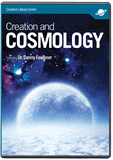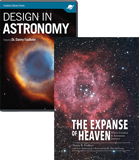What Were the Waters of Day Two?
One of the more common questions we receive at Answers in Genesis is what were the waters of day two of the creation week? Encompassing only three verses (Genesis 1:6–8), the account of day two says:
And God said, “Let there be an expanse in the midst of the waters, and let it separate the waters from the waters.” And God made the expanse and separated the waters that were under the expanse from the waters that were above the expanse. And it was so. And God called the expanse Heaven. And there was evening and there was morning, the second day.
Notice that the expanse God made on day two is intimately related to the waters of day two. God made the expanse amidst the waters to separate waters above the expanse from waters below the expanse. So, this raises a second question, what is this expanse? We probably can’t answer these two related questions separately, but they must be answers in tandem. Further complicating the issue is that older English translations of the day two account used the word firmament rather than expanse. The former word suggests something hard, while the latter word doesn’t give that impression at all. We shall get to that issue in due course, but first let’s start with the waters.
God created the earth in verse 1. However, the earth as God created it at the beginning was far from complete, for verse 2 states,
The earth was without form and void, and darkness was over the face of the deep. And the Spirit of God was hovering over the face of the waters.
“Without form and void” is better rendered as “unformed and unfilled.”
“Without form and void” is better rendered as “unformed and unfilled.” Over the following days of the creation week, God worked to shape the creation and fill it. This includes the work of day two. Notice that initially there was darkness over the deep. The word “deep” here refers to deep bodies of water. Land did not exist (or perhaps appear) until day three, so the initial earth was either entirely water or at the very least the earth was completely and deeply covered with water. Lest there be any doubt about this, the next phrase says that God’s spirit moved “over the face of the waters.” This importance of water in the creation is echoed elsewhere in Scripture (e.g., Psalm 136:6; 2 Peter 3:5). On day two, it suited God’s purpose to divide the waters into two, with the expanse in between the two. Perhaps getting a handle on what the expanse is will help in understanding what these upper waters are.
Early Influences
Key in deciphering the identity of the expanse is the clue that God called the expanse “heaven” (v. 8). Three times the account of day four (Genesis 1:14, 15, 17) says that God placed the luminaries (sun, moon, and stars) in the “expanse of heaven.” So, wherever the heavenly bodies are, that would be the expanse. Today we would say that the location of the heavenly bodies is (outer) space, so perhaps to people in the 21st century, the best identification of the expanse would be the space of the universe. However, we must be careful, for our modern understanding of cosmology is of recent origin. With a different cosmology, people in the past may have thought of the expanse a bit differently than we do today.
The Greek cosmology of that day featured a spherical earth at the center of a hard, transparent celestial sphere to which the astronomical bodies were attached.
For instance, the Hebrew Old Testament was translated into Greek in the 3rd – 2nd century BC. The Septuagint (abbreviated LXX), as this translation is called, was translated in Alexandria, Egypt. Alexandria was the major city of Greek culture and learning at the time. The Greek cosmology of that day featured a spherical earth at the center of a hard, transparent celestial sphere to which the astronomical bodies were attached. The LXX translators chose the Greek word stereoma to translate the Hebrew word raqia, the thing God made on day two. Stereoma has the meaning of something hard or firm. In the New Testament, the Apostle Paul used the same Greek word when he commended the Colossian church for the firmness of their faith in Christ (Colossians 2:5). When Jerome translated the entire Bible into Latin (the Vulgate) in the late 4th century, he chose the Latin word firmamentum to translate raqia. As you may surmise, we get our English word firm from the same root that this Latin word comes from. Therefore, this is a good translation of the Greek word stereoma. But is it a good translation of the Hebrew word raqia? No, because raqia doesn’t mean something firm or hard. Rather, raqia means “expanse.” So, why did Jerome translate raqia as firmament? The cosmology of Jerome’s day was the same as it was 6-7 centuries earlier when the LXX was translated, so Jerome probably believed the hard, transparent celestial sphere model best fit the day four description of where the heavenly bodies were. Therefore, Jerome probably concurred with the LXX and chose the appropriate Latin word firmamentum to translate stereoma.
This mistranslation of raqia that persisted for more than two millennia is a cautionary tale for us to be careful not to impose our understanding of cosmology onto the Bible.
John Wycliffe completed the first English translation of the Bible in the late 14th century. Wycliffe translated from the Vulgate, not the original languages of the Bible. Wycliffe transliterated the Latin word firmamentum into English as “firmament,” thus coining a new English word. Why did Wycliffe do this rather than properly translating raqia as “expanse?” There were at least two reasons. First, Wycliffe did not know Hebrew, so he probably didn’t know about the word raqia, nor did he know its meaning. Consequently, Wycliffe relied upon Jerome’s translation, and he knew Latin, so Wycliffe probably thought his transliteration was the best way to render the Latin word firmamentum. Second, the hard, clear celestial sphere model was still the dominant cosmology in Wycliffe’s day, and it would continue to be so for two to three more centuries. Wycliffe likely found this translation consistent with the cosmology he believed. By the time of later translations such as the King James Version (KJV), study of Hebrew and Greek for the purpose of translating directly from the biblical languages was in vogue, and so the true meaning of raqia was known. But it wasn’t until the 20th century that the more correct “expanse” began to show up in English translations (though the Geneva Bible, which preceded the KJV, had a footnote that read “or, spreading over, and air,” and the 1862 Young’s Literal Translation used “expanse”). This mistranslation of raqia that persisted for more than two millennia is a cautionary tale for us to be careful not to impose our understanding of cosmology onto the Bible. It is alright for us to express what we think the meaning is in terms of our cosmology, but we must not impose any meaning onto the Bible.
Heavenly Problems
Another consideration is what the word heaven means. Immediately we have a problem, because the Hebrew word for “heaven,” shamayim, is a dual form, having no difference between the singular and plural. But in English there is a difference between the singular and plural forms of heaven, so it is the sense of the translator to decide whether “heaven” ought to be plural or singular in any given verse. Heaven refers to everything above us. As such, the word heaven seems to have three distinct meanings in the Bible. What many people consider to be the first heaven is where the birds and clouds are. A good example of this is the description of the “birds of the heavens” found in Genesis 1:26, 28, and 30, though in some translations the less literal “air” is substituted for “heaven.” What people often call the second heaven is where the astronomical bodies are. Examples of this would be the giving of the Abrahamic covenant (Genesis 22:17). The third heaven is the abode of God. This is the meaning that the Apostle Paul had in mind when he wrote in 2 Corinthians 12:2 that he was caught up to the third heaven (Paul’s term).
At the risk of imposing our modern cosmology, we might understand the first heaven to be the atmosphere and the second heaven to be space. And we likely would think that the third heaven is beyond the physical world that we know. But is this the true meaning of these three? Where does the atmosphere end and space begin? There is no definite line of demarcation between the two. Therefore, we cannot say where the first heaven ends and where the second heaven begins. Nor could ancient people, including the Hebrews. They seemed to have understood there was a difference between the first and second heavens, but they didn’t seem to be concerned with the question of exactly where the boundary between the two laid. The Hebrews probably didn’t have difficulty with this fuzzy distinction, but we moderns tend to be too precise for our own good sometimes. As for whether the third heaven is physical and just beyond the first two heavens, the ancients didn’t seem to have a problem with ambiguity there either, though we moderns seem to have some difficulty with it.
Which heaven does the day two account of Genesis 1:6–8 refer to? That is not entirely clear. It would not seem to mean the third heaven. It could refer to either the first or second heaven, both, or portions of the two.
A half-century ago, most recent creationists subscribed to the canopy model, the belief that the expanse is the earth’s atmosphere with the waters above being in a sort of canopy over the atmosphere.
Expanse and Water
With these caveats in mind, let us consider the possibilities of what the expanse is and hence what the waters above are. A half-century ago, most recent creationists subscribed to the canopy model, the belief that the expanse is the earth’s atmosphere with the waters above being in a sort of canopy over the atmosphere. The canopy model hypothesized that the water canopy collapsed at the time of the flood (the “windows of heaven” being opened at the beginning of the flood per Genesis 7:11 and 8:2). We don’t see these waters above now because the canopy no longer exists. While some creationists still support the canopy model, most creation scientists do not, nor do most major creation ministries, such as Answers in Genesis. Why has support for the canopy model eroded? There are two primary reasons. One reason is that despite much effort expended to make a physical model of the canopy viable, no such working model was ever produced. More importantly, the canopy model has some scriptural problems. For instance, Psalm 148:4 speaks of the waters above the heavens as if they still exist. Psalm 148 was almost certainly written after the flood, so why would it mention waters above the heavens if those waters are not there anymore?
Another possibility is that “waters above the heavens” simply refers to atmospheric water, water that is continually recycled via the hydrologic cycle through evaporation and precipitation. The problem with this answer is that the water in the atmosphere is hardly above the heavens. Rather, that water is in, not above, heaven, and the first heaven to boot. This does not seem to comport with the day four description (three times) of the heavenly bodies being in the expanse of heaven, with the terminology “expanse of heaven” apparently referring to what God made on day two. How could atmospheric water be said to be above the place where the sun, moon, and stars are?
This leaves the possibility that the waters above the expanse are beyond the realm where we find astronomical bodies. This would imply that there is a shell of water surrounding the universe. What form (solid, liquid, or gas) would this water take? Considering that, just like English, there are Hebrew words for ice and water vapor, the use of the Hebrew word for liquid H2O means liquid water, so we ought to conclude that this water is liquid. A shell of water around the universe would not be possible if the universe were infinite, so the universe must have a finite size. Modern cosmologists who reject biblical cosmology are split on whether the universe is finite or infinite. But there is something even more profound here. For there to be water at the edge of the universe, the universe must have an edge. The universe having an edge is anathema to modern cosmologists. Those cosmologists who believe the universe is finite think that the geometry of the universe closes back on itself, sort of the way that the two-dimensional surface of a sphere closes back on itself so that it has no edge. Since God moved this shell of water outward from the earth when He made the expanse on day two, then the cosmology of the Bible suggests that the earth is somewhere near (but not necessarily at) the center of the universe. The idea that the universe has a center and that the earth is near that center also is anathema to modern cosmology.
There is an interesting implication coming from this cosmology gleaned from Genesis 1. If there is water at the edge of the universe, then that water must have nonzero temperature.
Implications and Conclusion
There is an interesting implication coming from this cosmology gleaned from Genesis 1. If there is water at the edge of the universe, then that water must have nonzero temperature. Normal matter, such as water, that has nonzero temperature must radiate. Therefore, there should be electromagnetic radiation from the shell of water coming toward earth from all directions. We don’t know what temperature this radiation will have because we don’t know what the temperature of the water is. Furthermore, the Hubble relation tells us radiation coming from a distant source will be redshifted, effectively cooling the temperature of the radiation, but we don’t know how much redshift there will be. All we can say is that there ought to be a low-temperature radiation field in the universe. Arno Penzias and Robert Wilson discovered a 2.73 Kelvin radiation field in 1964. This cosmic radiation background (CMB) was hailed as proof of the big bang model, as cosmologists using the big bang model had predicted the existence of a low-temperature radiation field 16 years earlier. However, other hypotheses, such as the water of day two creation, predict a CMB too. Rather than evidence of the big bang, perhaps the CMB is evidence of the biblical creation account.
To sum up, the cosmology of the day two and day four accounts suggests that the expanse God made on day two is what we would call space, but it likely includes most, if not all, the atmosphere as well. There is water at the boundary of the universe. This means that the universe is finite, has an edge, and the earth may be near the center of the universe. However, this does not imply strict geocentrism, that the universe moves around the earth. The CMB may be evidence for this cosmology.
Recommended Resources

Answers in Genesis is an apologetics ministry, dedicated to helping Christians defend their faith and proclaim the good news of Jesus Christ.
- Customer Service 800.778.3390
- © 2024 Answers in Genesis








